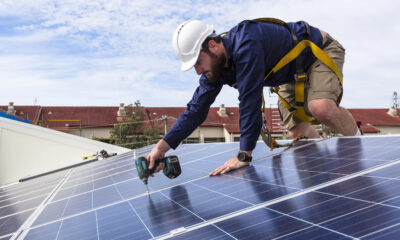News
Feed-in tariff solar subsidies face cuts by half
As expected, the long term subsidies for installing solar panels in your home are likely to be cut by 50%, pending a final consultation. Alex Blackburne looks into the decision.
The Government is expected to halve solar panel subsidies from April by as much as 50%, adding to the continuing controversy over the plans.
 As expected, the long term subsidies for installing solar panels in your home are likely to be cut by 50%, pending a final consultation. Alex Blackburne looks into the decision.
As expected, the long term subsidies for installing solar panels in your home are likely to be cut by 50%, pending a final consultation. Alex Blackburne looks into the decision.
The Government is expected to halve solar panel subsidies from April by as much as 50%, adding to the continuing controversy over the plans.
Subsidies cuts to the UK’s solar feed-in tariff scheme have generated a fair amount of buzz on Blue & Green Tomorrow, having first covered the news in late October.
Not long after that, many high-profile environmental campaign groups voiced their disdain over the proposed slashes, with Friends of the Earth particularly angry at the plans, threatening legal action against the Government if the proposals weren’t amended.
Good Energy’s head of business development, Hugo House, has written two articles for Blue & Green Tomorrow on the subject – the first was a look at how the move to cut funding for the feed-in tariff scheme will affect the solar industry, and the second explained how Good Energy’s offices were open over the critical final application weekend.
In House’s first contribution, he wrote, “The Government had proposed that solar projects registered after December 12th this year will get a lower Feed-in Tariff rate than the current level, with many solar companies claiming the plans will cause widespread unemployment, with businesses not able to continue without support“.
Despite the opposition from the industry, the Government has continued with its plans to cut the subsidies for solar panels in the UK from next April – by as much as 50%.
It is feared by some that the slashes will cause a decrease in solar users across the country, as we attempt to catch up the world leaders in renewable energy. Juliet Davenport, founder and CEO of Good Energy, remained positive.
“Despite the reduction in the tariff, we believe that solar PV remains a good investment for households looking to shelter themselves from volatile energy prices whilst reducing their carbon footprint“, she said.
“The scheme should become more accessible as the price of solar panels continues to fall. We’re really proud of our community of over 8,000 independent generators – the mini-power stations of the future.”
1BOG recently produced a smart infographic depicting the top ten countries in terms of solar power usage. Rather unsurprisingly, the UK do not feature on the rundown, but European neighbours Belgium, France, Spain, Germany, Czech Republic and Italy all make it.
The fundamental message from everyone within the solar industry is for newcomers to the sector not to be put off by the cuts.
The near-term incentives might not be as lucrative as in the past, but if you want the Earth to be a sustainable one in the future, long-term incentives for choosing solar power, or any kind of renewable energy for that matter, will be the most profitable you will have ever experienced.
One of the biggest challenges with the changes to the feed-in tariff is that because they came ahead of the planned review, not many people were expecting it.
The government cannot expect investors to support renewable energy projects if the rules are changed part way through an investment cycle.
We need consistent policy and stability within government, which would subsequently allow private money to flow into new, clean, green technology.
If you would like to find out more about investing in renewable energy, then contact Good Energy.
Photo: Sustainable sanitation.


 Environment9 months ago
Environment9 months agoAre Polymer Banknotes: an Eco-Friendly Trend or a Groundswell?

 Environment11 months ago
Environment11 months agoEco-Friendly Home Improvements: Top 7 Upgrades for 2025

 Energy12 months ago
Energy12 months agoA Closer Look at The Rapid Growth of Solar Energy in Ireland

 Features8 months ago
Features8 months agoEco-Friendly Cryptocurrencies: Sustainable Investment Choices


















